The destructive power of fragile masculinity: Terence Fisher’s Four Sided Triangle (1953)
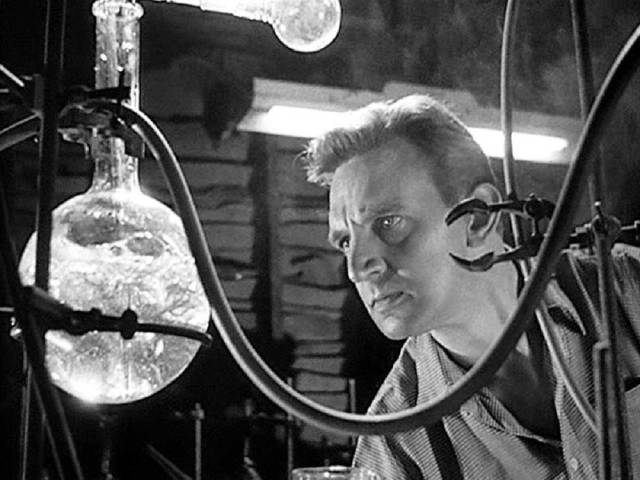
I first saw Terence Fisher’s Four Sided Triangle (1953) on laserdisk in the late-’90s, and again in an Anchor Bay two-disk DVD set from 2004 (along with Leslie Norman’s X the Unknown [1956]), and yet again as an extra on Lion’s Gate’s Curse of Frankenstein (1957) Blu-ray released in 2012. I liked it right from the start despite its generally low reputation, and have appreciated it more on each subsequent viewing. This is no doubt partly a matter of personal taste, but as the various supplements in Hammer’s new 4K edition argue, it’s a much more complicated and interesting movie than it’s generally been given credit for.
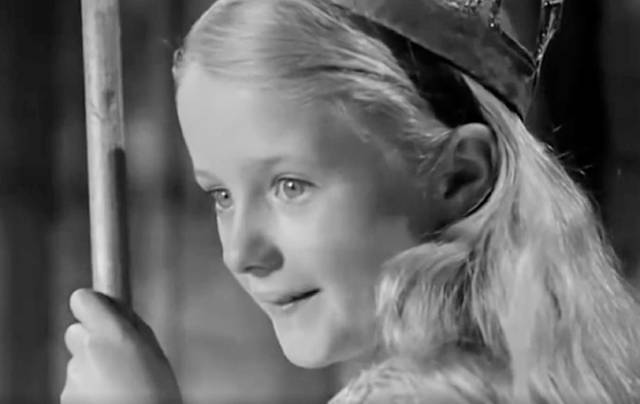
Terence Fisher had made more than a dozen features in five years before taking on this, his third assignment for Hammer Films, and despite the reputation he would gain a few years later as the company’s signature director of Gothic horrors, in some ways this modest, low-budget production was a more perfect fit for his sensibilities – always chafing at the label of horror filmmaker, Fisher saw himself as a romantic whose fantasies were fables rooted in subtler emotions than simple terror (it may be significant that this was one of only two movies Fisher co-wrote, the other being the same year’s thriller Man in Hiding, also co-written by Paul Tabori). Although the science fiction trappings of Four Sided Triangle are crucial to the plot, the film is actually a rather dark study of romantic obsession which becomes deeper and more perverse as it progresses, exploring similar themes to Alfred Hitchcock’s Vertigo (1958) – the extremes to which damaged masculinity will go in objectifying women in order to possess a distorted, and damaging, “ideal”.
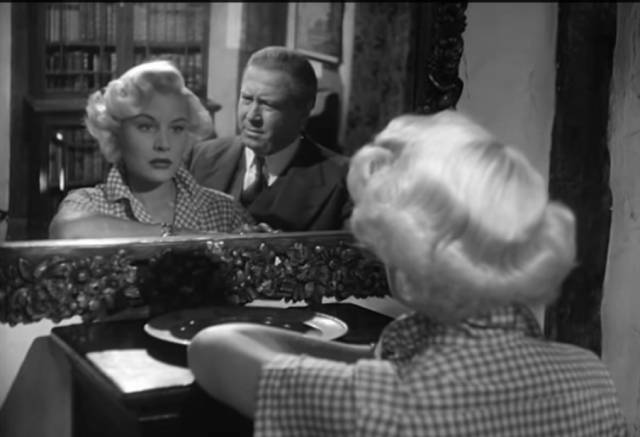
Some of the negative opinion is rooted in limitations imposed by the low budget, and yet the film is well-designed and beautifully shot by Reginald H. Wyer (who had previously photographed Fisher’s first great movie, So Long at the Fair [1950]). It’s true that excessive narration is often a bad sign, and here much of the story is told through voiceover by avuncular village doctor Harvey (James Hayter), though this observer character eventually comes to play a more interesting and troubling role in events as they unfold, making his low-key commentary more problematic than it first seems.
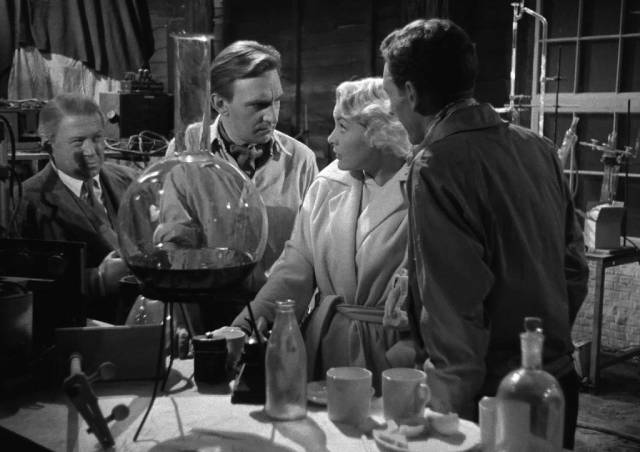
Newly arrived in the village, Dr. Harvey encounters the three childhood friends Robin (son of the local landowner), Bill (son of a poor family plagued by alcoholism) and Lena. The latter is a haughty, self-possessed girl who enjoys having the two boys fight for her favour. When Harvey first sees them, she sits on a makeshift throne in an old barn, holding a staff and urging the boys – her “knights” – to fight with their wooden swords. Though the doctor smiles indulgently, the fight is actually quite furiously intense, and when Robin forces Bill to submit, Bill flees in humiliation. Later, after the death of his parents, Bill becomes the doctor’s ward and is introduced to science, for which he develops a voracious appetite, quickly surpassing Harvey’s own knowledge.
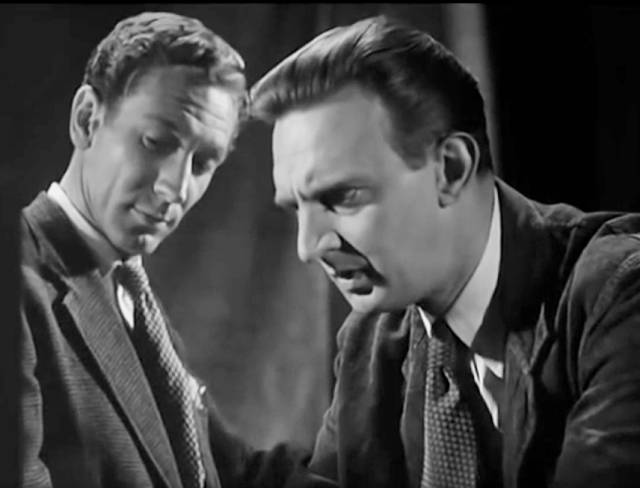
Time passes, Lena returns to the States with her mother, and the boys go off to university. The plot driver of the film is Bill’s obsession with an invention he conceived at university, his work supported by the more prosaic Robin, whose father kicks in the initial funds to set up a lab in the old barn. Rooted in Bill’s theory that just as it’s possible to transform matter into energy, it should also be possible to convert energy into matter, his machine – the Replicator – is something like Seth Brundle’s matter transmitter in David Cronenberg’s The Fly (1986), although rather than breaking down matter into energy and then reconstituting it in a different location, Bill’s machine creates an exact duplicate of the original.
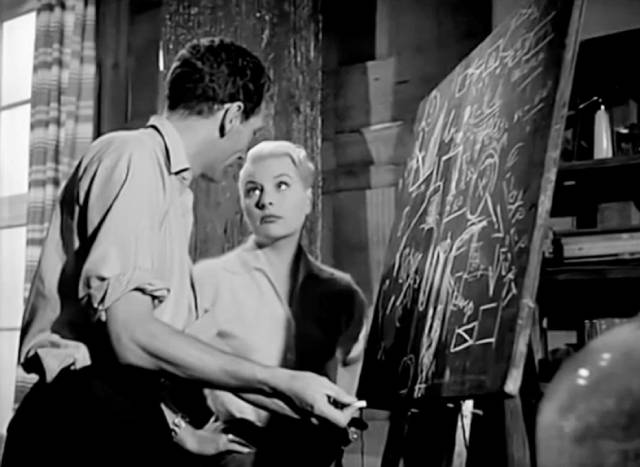
While Bill is driven primarily by the sheer excitement of research and invention, there is an idealistic impulse behind his work – the Replicator could end famine, make crucial drugs cheap and accessible, and reduce the cost of living for everyone on the planet. As always, there’s a blind spot about potential unintended consequences (as Neil Sinyard points out in one of the disk extras, there’s an interesting parallel here with Alexander Mackendrick’s The Man in the White Suit [1951].) Once the machine has proved viable, some of those consequences become apparent when Robin’s father insists that further development requires government involvement, immediately raising issues of national security and military uses. But the script, doesn’t pursue this thread very far because its concerns are more personal.
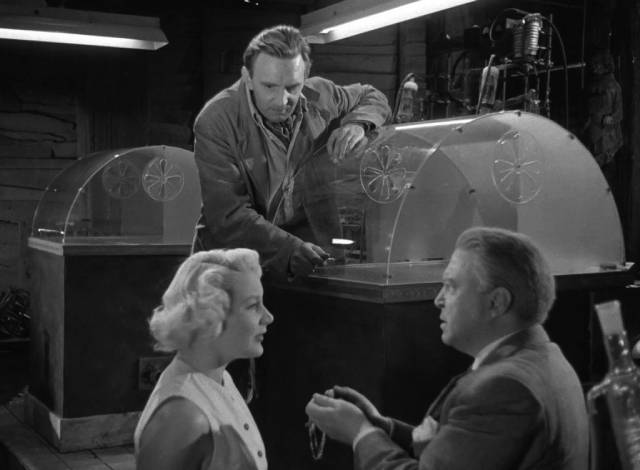
While Bill and Robin tinker away in their makeshift lab, Lena returns to the village to settle her late mother’s affairs. Although no details are provided, she tells Dr. Harvey that she has failed in her ambitions and, not having asked to be born, intends to commit suicide when her business is finished. He’s appalled – “no one has that right” – and diverts her attention by telling her about her two friends and their mysterious work. When he takes her to the barn, she’s received warmly and seems to find at least a temporary purpose … which is where the film most clearly reflects its period. While as a child she seemed to hold the power in the trio of friends, she’s shut out of the scientific work being done in the barn; as adults, the two men are all business, neglecting the prosaic details of life in their passionate pursuit of knowledge. What better role for Lena, then, than den mother, tidying up, making sure they’re properly fed and rested. In this world, the only role open to a woman is seemingly a subservient one, freeing men to do their important work.
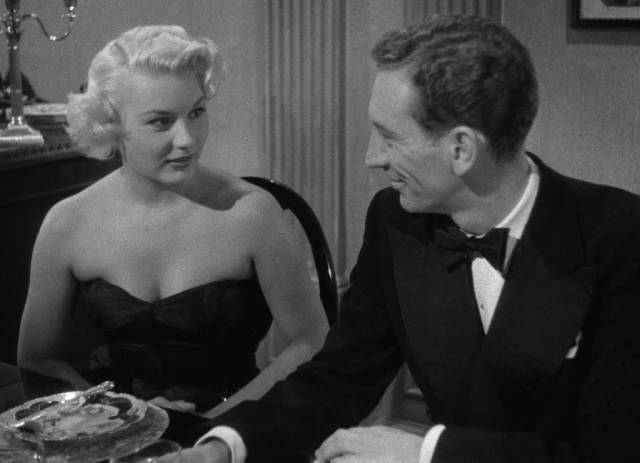
It’s her submission to this role which leads to tragedy. Bill, still shy and insecure, is unable to express his love for Lena and, having waited too long, is devastated when she and Robin announce their plans to marry. But while they’re away on their honeymoon, he conceives of a way to fix his “problem”; he continues to refine the Replicator and runs tests on live animals. At first, the duplicates materialize dead, but he figures out a way to jump start them – prefiguring the work of Dr. Frankenstein in the film Fisher would make four years later, launching Hammer’s signature Gothic horrors. Then, when Lena and Robin return, he finally tells her that he has always loved her and that it’s in her power to relieve his pain and make him happy.
The obvious moral and ethical problems of his plan are pushed aside and Lena agrees. Her desire not to hurt Bill, however, ignores the issue of the proposed duplicate’s autonomy; he wants to create a woman – identical to Lena – for him to possess, to satisfy his own emotional needs. The limited role available to Lena herself is here reduced even further; objectified in the extreme, the duplicate will be a possession whose sole function is to serve Bill’s romantic obsession. This prefigures Scotty’s obsession in Hitchcock’s Vertigo; a woman ceases to be an individual with her own identity and becomes a projection of the romantic ideal of a man so wrapped up in his own needs that he has lost all capacity for empathy.
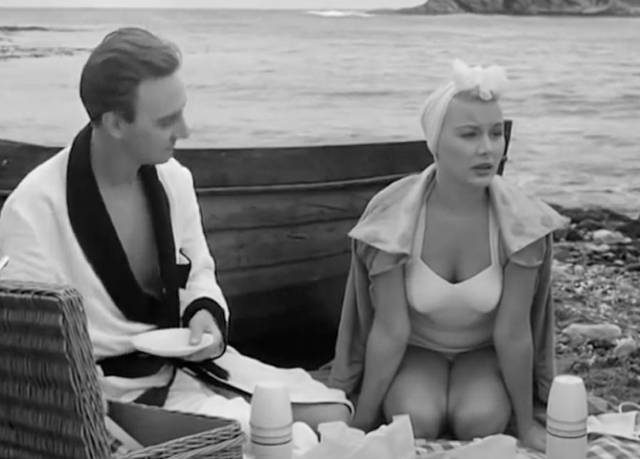
Ironically, the Replicator does its job all too well. The duplicate, dubbed Helen, is exact in every way; although seeming to accept the role assigned to her, she is actually far more complicated than the sex doll Bill has wanted. She has all Lena’s memories and, more importantly, all her feelings; she too loves Robin and being forced into a relationship with Bill, her earlier suicidal tendencies resurface. And yet even then, Bill refuses to relinquish his desire to possess her – and proposes something truly monstrous. He convinces Helen that they could still be happy together if only she allows him to erase her memory. For this, he enlists Lena’s help and back at the lab prepares to use electric shock to wipe Helen’s brain clean. The full implications of this are glimpsed in a subtle moment, unnoticed by Bill and Lena just before the power is turned on when Helen whispers “Goodbye, Robin”, knowing that she’s giving up everything that means anything to her in order to submit completely to Bill’s selfish desire.
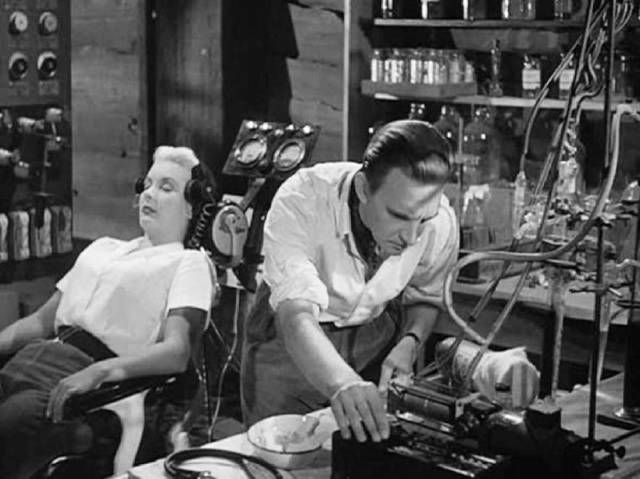
The ending is slightly fumbled as it eschews the inherent ambiguity of the narrative to offer a seemingly reassuring conclusion; during the procedure, the equipment overheats and the barn erupts in flame – as all mad scientists’ labs must – with Bill and one of the women dying. The other woman, rescued by Robin, emerges with amnesia, leaving open the possibility that it’s Helen rather than Lena who has been saved … until Dr. Harvey finds a way to prove that she’s the original, suffering from trauma, but no doubt soon to mend and resume her life with Robin.
The darkness which suffuses the film is not entirely apparent at first, rooted as it is in the cosy trappings of the small village setting, framed within Harvey’s indulgent, avuncular perspective. But scratching beneath the surface, not only do we get Bill’s increasingly dangerous obsession – there’s also Harvey’s own active role in events, as he contributes funds when Robin’s father cuts off his contributions and becomes actively involved in the plan to duplicate Lena despite offering some moral objections; and then there’s also Lena herself, who acquiesces to the plan to create a woman identical to herself simply to assuage Bill’s bruised feelings of rejection … her cooperation going so far as to help erase her twin’s memories and feelings because Bill still hasn’t got what he wanted. This denial of Helen’s autonomous existence is inexpressibly cruel.
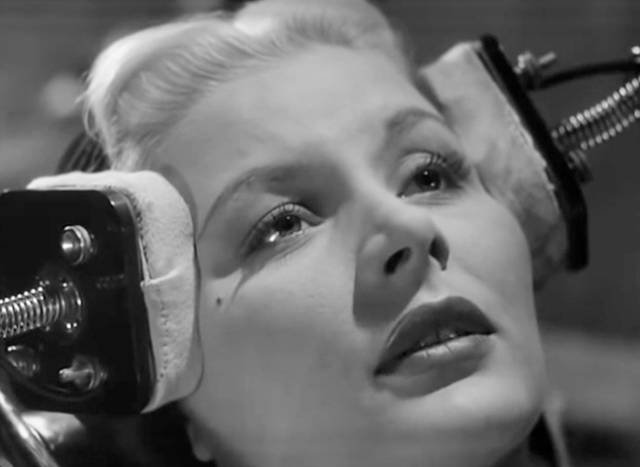
For a small, modestly budgeted melodrama with sci-fi trappings, Four Sided Triangle is a surprisingly rich piece of work which prefigures not only Hammer’s Frankenstein franchise, but also numerous later films which explore issues inherent in the concept of AI – such as Ridley Scott’s Blade Runner (1982), Caradog W. Jones’ The Machine (2013), Alex Garland’s Ex Machina (2015), even Drew Hancock’s Companion (2025). If the script is a bit too talky at times, the cast is excellent, with Stephen Murray keeping a tight rein on Bill’s increasing madness, James Hayter grounding the more fanciful elements as Dr. Harvey, Barbara Payton displaying a strength as Lena, and later Helen, which belies the limited role her character has in this world dominated by masculine arrogance and insecurity. Perhaps the weakest link is John Van Eyssen, who does what he can with the somewhat underwritten role of the sidekick who serves as a counterpoint to Bill’s obsessively driven protagonist.
*
Hammer’s 4K restoration from the original negative looks terrific, Wyer’s cinematography sharp, detailed and atmospheric. The production design creates a convincing semi-professional lab, and Fisher’s direction evokes both the pastoral calm of the setting and the dramatic impact of the experiments. The original mono soundtrack is quite robust, with a lot of detail in the lab scenes (all that electrical equipment) and a strong presentation of Malcolm Arnold’s score, which adds to the dramatic impact of the film. There’s also an Atmos 5.1 remix, which seems rather forced and unnecessary.
There are two commentary tracks (one with Melanie Williams and Thirza Wakefield, the other with Jonathan Rigby and Kevin Lyons), plus a somewhat rambling conversation between William Fowler and Vic Pratt, a more focused interview with Neil Sinyard, and an interview with Lucy Bolton about the troubled life and career of Barbara Payton. Also included in the set is a 120-page book of essays, interviews and sample pages from two attempts to remake the film in the 1990s.
Like Hammer’s impressive package for Captain Kronos: Vampire Hunter, this is an excellent set and bodes well for their upcoming releases of The Quatermass Xperiment (1955) and Quatermass II (1957) . Along with their current release of Shatter (1974), these initial special edition restorations are an interesting mix of the company’s less well-known productions. It’ll be interesting to see what comes next.
Comments